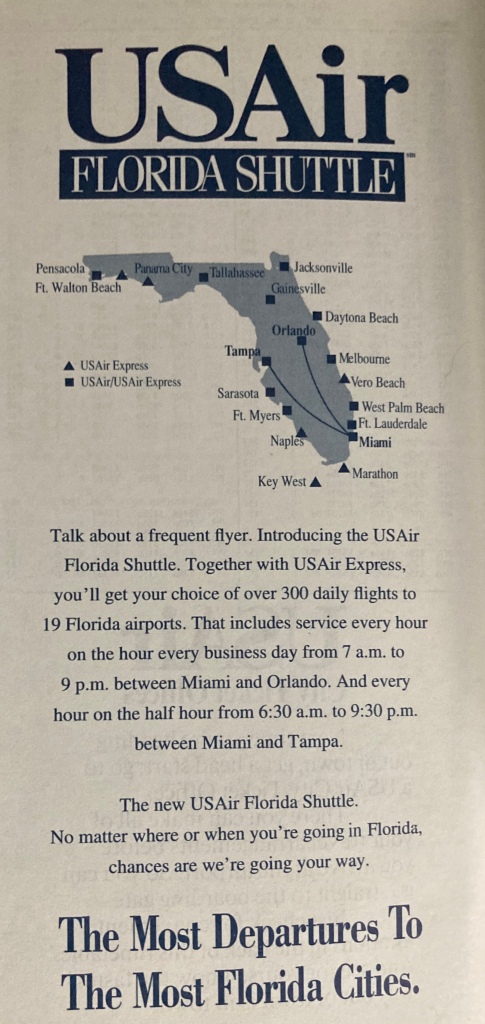Before Brightline there was the USAir Florida Shuttle
In early 1993, USAir (later known as US Airways) with newly-minted investment from British Airways launched the USAir Florida Shuttle to link cities within the state to one another. The shuttle featured hourly nonstops between Miami and Tampa/Orlando similar to USAir’s Northeast Shuttle which did the same between New York-LaGuardia and Boston/Washington-National. The shuttle also featured frequent nonstops between Fort Lauderdale and Tampa/Orlando (almost hourly but not quite) and Miami and Jacksonville (6 roundtrips a day). It also linked smaller points in the state via prop planes.
USAir was making a big bet on Florida. The Shuttle also featured its own frequent flier program the “USAir Florida Shuttle Club” which rewarded passengers based on flight segments not miles.
Building up Florida
From the moment Eastern Airlines workers went on strike in 1989 (the airline never recovered) USAir which merged with Piedmont that year became the rival for Delta in transiting passengers to and from the Sunshine State. USAir’s strategy was haphazard as opposed to Delta who had built a hub in Orlando and significant focus city (using today’s terms) in Fort Lauderdale and international gateway in Miami while maintaining high-end brand recognition in the Tampa Bay and Fort Myers markets. But in 1992, USAir surpassed Delta as Tampa’s largest airline and had become a fairly competitive number two at both Orlando and Fort Lauderdale.
Shuttle Launches
So with this in mind USAir launched its Florida Shuttle in early 1993 to consolidate its position in the Sunshine State. Linking 19 airports in the state was ambitious – too ambitious.
Hourly flights from Miami to/from Orlando and Tampa was overkill and other services were niche. But there was business traffic within the state but perhaps not enough to justify so many flights. And with the destinations close, driving was always an option.
The shuttle was short lived for a myriad of reasons.
Competition
Delta’s Delta Connection brand which was operated by ComAir flew many of the same routes with a connecting hub in Orlando to transit passengers quickly and another in Fort Lauderdale to connect Florida passengers to the Bahamas. Delta’s superior frequent flier base and reputation ailed USAir who was trying to compete for the same passengers. Also American Airlines large Miami hub made it difficult for anyone to compete on flights to/from Miami (which is why in the late 1990’s Fort Lauderdale rapidly emerged as the choice destination for other airlines).
Additionally USAir couldn’t stimulate in-state traffic to places like Naples, Vero Beach, and Northwest Florida. Any interest in air travel to those places came from out-of-state, if at all (Naples currently has no commercial air service. Vero Beach, Destin/Fort Walton Beach and Panama City have zero flights within the state currently- every route to those airports 30 years later is from out-of-state).
Enter Southwest and High Speed Rail talk
In 1996, Southwest Airlines would enter the state, not so ironically beginning service with frequent Fort Lauderdale to Tampa/Orlando flights before ultimately connecting out-of-state destinations to Florida.
All of this having been said, having a major US airline commit to the concept of a “Florida Shuttle” like airlines had done in the Northeast said a lot about the state’s growth in the 1980s and 1990s. Ultimately, this led to a move to push High-Speed Rail in the state which passed as a ballot initiative in 2000.
The failure of the state to build the High-Speed line that was approved by voters was down to sinister politics and a desire of some to curtail Florida’s growth. Last month, Brightline launched Higher-Speed (but not High-Speed) services between Orlando/Miami/Fort Lauderdale/West Palm Beach, 30 years after US Air’s Florida Shuttle filled the skies.













